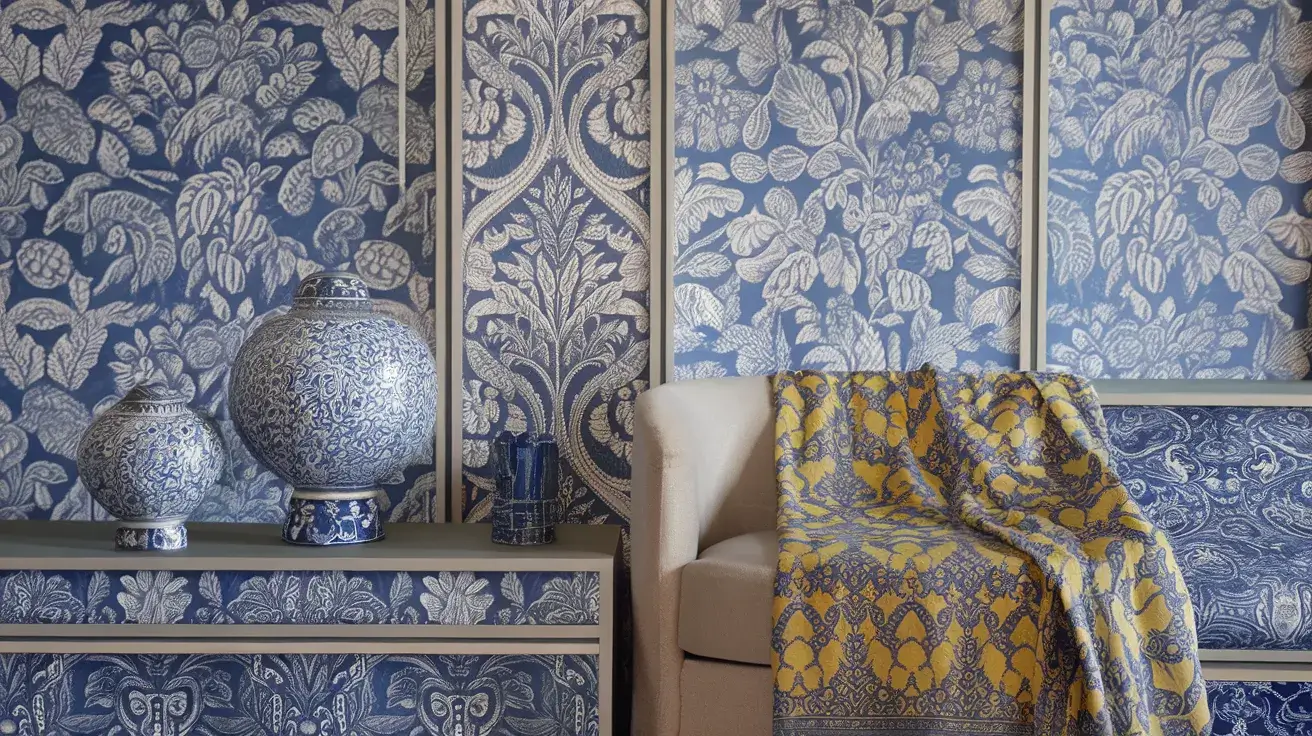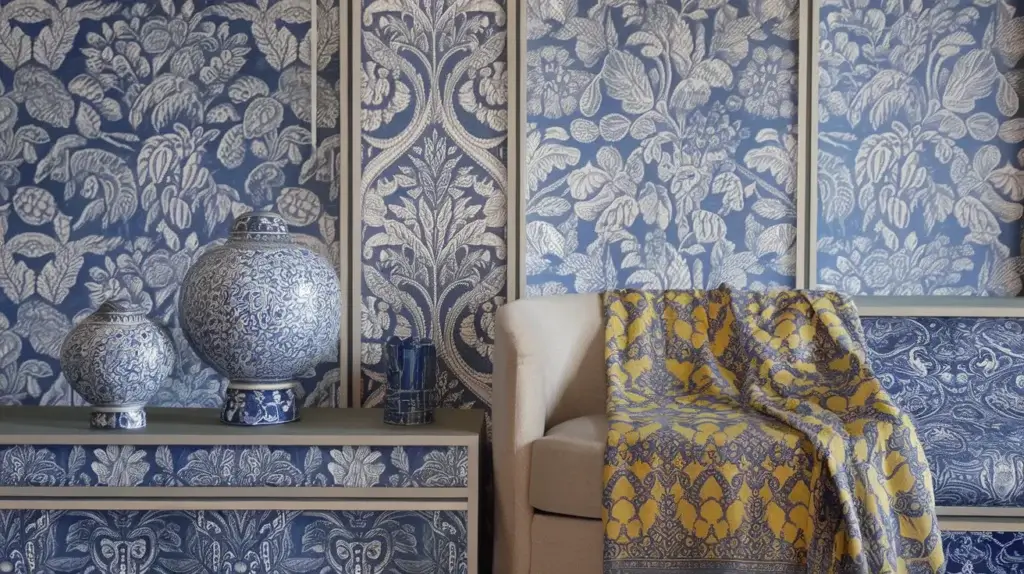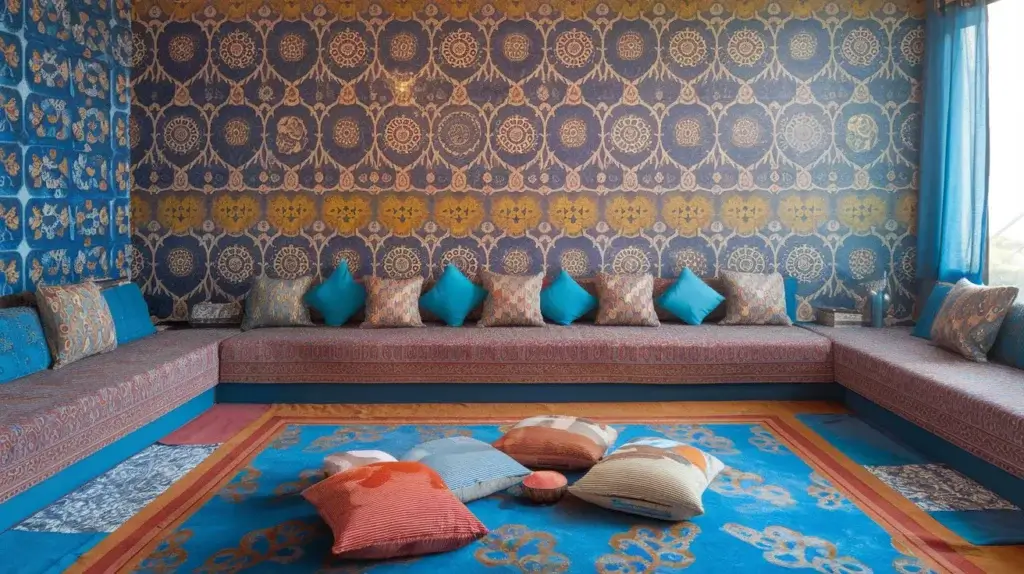Follow us for daily interior design inspiration!

How to Use Repeated Decorative Design in Your Home Décor
I’ve always been fascinated by how a Repeated Decorative Design can transform a room. By using the same design elements repeatedly, you can create a sense of cohesion and visual interest in any space. In this article, I’ll share key ideas, tools, and methods to help you incorporate repeated decorative design into your home décor.

Table of Contents
Understanding the Principles of Repeated Decorative Design
Decorative design elements repeated in a space can make it visually appealing and harmonious. It’s key to grasp the design principles, the psychology behind pattern repetition, and visual rhythm techniques. These are crucial for creating effective repeated designs.
The Psychology Behind Pattern Repetition
Humans are drawn to patterns because they find comfort and familiarity in them. Repeated patterns bring balance, stability, and order. This can calm and centre the observer. Patterns also create visual interest, making us want to look closer. To dive deeper into the psychology of design, check out this article on pattern psychology
Basic Design Elements in Repetition
The main design elements for repeated decorative design are lines, shapes, textures, and colors. These elements can be combined to create striking patterns that define a room’s overall look. It’s essential to consider placement, scale, and proportion to ensure a cohesive repeated decorative design that flows seamlessly throughout the space.
Creating Visual Rhythm in Spaces
Creating a visual rhythm is a key technique in repeated design. By placing patterns thoughtfully, designers can lead the viewer’s eye through a space. This creates movement and flow. Rhythm is enhanced by colours, textures, and other design elements.

“Patterns have the power to transform a space, creating a sense of unity, balance, and visual interest that can elevate the overall design.”
Essential Tools and Materials for Pattern Creation
As a DIY fan, I’ve learned that the right tools and materials are key for making beautiful patterns at home. You can use old-school drafting tools or the latest digital software. The choices are endless, and so are the designs you can make.
For sketching out your designs, a good ruler, French curve, and compasses are must-haves. You’ll also need a rotary cutter, mat, and scissors for cutting your patterns accurately. If you like working digitally, pattern-making software and vector graphics programmes can help you create smooth, repeating patterns.
| Pattern-Making Tools | Design Materials |
|---|---|
| Ruler French curve Compasses Rotary cutter and mat Scissors Pattern-making software Vector graphics programmes | Fabric Wallpaper Scrapbooking paper Vinyl or contact paper Acrylic or oil paints Markers and pens |
When it comes to materials, you have lots of choices. You can use fabric, wallpaper, scrapbooking paper, or even vinyl or contact paper for your designs. For hand-drawing or painting, acrylic or oil paints, markers, and pens work well. The important thing is to try different materials to see what works best for you and your project.
Whether you’re into traditional or digital pattern-making, having the right tools and materials makes the process fun and easy. With a bit of creativity and experimentation, you can turn any room into a stunning, pattern-filled space.

Incorporating Geometric Patterns in Living Spaces
Geometric patterns can change the feel of any room. They add depth, interest, and a touch of class. Whether you like bold shapes or smooth curves, these patterns can make your home look better. Let’s see how to use them in different parts of your home.
Wallpaper and Wall Treatments
Wallpaper with geometric designs can make a room stand out. You can choose from many shapes like triangles, hexagons, diamonds, and chevrons. Match the wallpaper with other items to keep the look consistent. Or, paint geometric patterns on walls for a unique touch.
Floor Patterns and Layouts
The floor is a great place for geometric designs. Tiles, parquet, or rugs with bold shapes can make a room look deeper and more lively. Try different patterns like herringbone or diamonds to find the best fit for your space.
Ceiling Design Options
Remember to look up! Geometric patterns on the ceiling can be a stunning feature. Use tiles, beams, or paint to make a bold statement. This is especially effective in rooms with high ceilings, where the design can really shine.
By using geometric patterns in walls, floors, and ceilings, you can make a room that’s both beautiful and cohesive. Let geometry take your home to the next level.
Textile Patterns in Home Décor
Textile patterns are key to making your home look great. They add life to our sofas and chairs with fabric patterns, while curtain patterns make windows pop. These repeated decorative designs can completely transform any room.
Repeated decorative design is a big trend in upholstery. Choose a bold print or a soft floral for your furniture to enhance your living room. Pick patterns that work well together to create a cohesive look and tie the room together.
| Textile Pattern | Ideal Application | Visual Effect |
|---|---|---|
| Striped | Curtains, rugs, cushions | Creates a sense of energy and movement |
| Floral | Upholstery, bedding, accent pieces | Adds a touch of elegance and femininity |
| Geometric | Wallpaper, floor tiles, throw blankets | Lends a modern, sophisticated aesthetic |
Think about the scale and proportion of your patterns. Big patterns can make a statement. Small ones add a touch of elegance. Both can make your space feel cohesive.
Using textile patterns in your home lets you show off your style. It adds interest and makes your space welcoming. By using patterns wisely, you can make your home a beautiful, personal space.
Balancing Pattern Scale and Proportion
Finding the right balance between pattern scale and proportion is key when using repeated decorative designs at home. The size of the patterns greatly affects the look and feel of a room. Small patterns can add a subtle, elegant touch, while big patterns can make a bold statement.
Small-Scale vs Large-Scale Patterns
Small patterns, like delicate flowers or simple shapes, bring calm and serenity. They make rooms feel bigger and more open. In contrast, large patterns, such as big flowers or bold shapes, add grandeur and make spaces feel cozier.
Creating Focal Points Through Repetition
Using repeated patterns can create focal points in a room. A bold, large pattern on an accent wall or a big rug can grab attention. Surrounding it with smaller patterns helps balance the design.
Pattern Mixing Techniques
- Combine patterns of different scales for visual interest and depth.
- Opt for patterns with complementary colour schemes to ensure cohesion.
- Vary the motif styles, such as geometric and organic, to add complexity.
- Use repetition of a single pattern in multiple locations to create a sense of unity.
Understanding pattern scale and proportion is vital for creating stunning interior spaces. By mastering these principles, I can confidently use repeated patterns to make my home balanced, harmonious, and visually appealing.
Natural and Organic Repeated Patterns
I love the beauty and calm of nature. That’s why I’m excited to talk about using organic and nature-inspired patterns in home décor. These designs can really change how a space feels and how we feel in it.
Biophilic design brings the natural world into our homes. It uses patterns, textures, and shapes from nature. This makes our homes feel connected to the outdoors and more calming.
Using wallpaper or textiles is a great way to add biophilic patterns to your home. Imagine a wall with a beautiful leaf or flower design, or a chair with a fabric that looks like a river. These add beauty and make our homes feel soothing.
| Pattern Type | Inspiration Source | Recommended Placement |
|---|---|---|
| Leaf and Floral | Botanical Patterns | Walls, Textiles, Accents |
| Ripple and Wave | Water Formations | Flooring, Wallpaper, Artwork |
| Honeycomb and Hexagon | Beehive Structures | Backsplashes, Furniture, Accessories |
Using organic patterns and nature-inspired designs makes our homes calm and connected to nature. It’s a green and beautiful way to design our homes. I think it really improves our well-being and how much we enjoy our homes.
Colour Theory in Repeated Design Elements
Colour theory can make your repeated designs look amazing. It helps create spaces that are both beautiful and engaging. By understanding colours, you can make your patterns work together perfectly.
Monochromatic Pattern Schemes
Monochromatic designs use one colour in different shades. This makes your space look elegant and calm. Try using different textures and scales to make it interesting.
Complementary Colour Patterns
Complementary colours, like blue and orange, add energy to your space. They create bold, eye-catching areas. Make sure the sizes and shapes of these patterns match well.
Using colour theory in your designs can make them look better. It brings everything together and can even change how you feel in a room.
Modern Applications of Traditional Pattern Motifs
In the world of interior design, mixing old and new is now popular. Designers and homeowners want spaces that look great and have deep meaning. They use classic pattern motifs to achieve this, blending traditional motifs with modern design.
For example, intricate floral patterns are back in wallpaper and fabrics. These traditional motifs now have bold colours and abstract styles. They fit well with today’s contemporary patterns.
The style of Chinoiserie is also making a comeback. It features delicate, hand-painted designs. Designers are updating these traditional motifs into contemporary patterns that catch the eye today.
Geometric patterns are also being used in new ways. They add rhythm and dynamism to modern interiors. These traditional motifs are now seen in floor tiles, upholstery, and wallcoverings.
By combining traditional motifs with contemporary patterns and modernised designs, we can create special spaces. These spaces are rooted in history but also look to the future. This mix of old and new makes interiors that are both beautiful and meaningful.
Conclusion
Exploring repeated decorative design can completely transform how our homes look and feel. Geometric patterns on walls and organic textures in fabrics add rhythm and visual interest, making our spaces more engaging.
Whether you love classic designs or sleek, simple patterns, it’s all about finding what resonates with you. By incorporating scale, proportion, and colour theory, you can create a home that reflects your personal style and taste.
Let your creativity flow with repeated decorative design. With a little imagination and the right approach, your home will showcase your unique style, becoming a beautiful and creative space.
FAQ
What is the importance of repeated decorative design in home décor?
Repeated decorative design is key to making spaces look good and feel connected. It can change a room’s look, add personality, and improve your home’s style.
How do the principles of repeated design work in interior design?
The principles of repeated design are about understanding why patterns work and knowing the basics. They help create a flow in your space.
What tools and materials are needed for creating pattern-based designs?
There are many tools and materials for making patterns in your home. You can use stencils, stamps, or digital software, depending on your preference.
How can I incorporate geometric patterns into different areas of my living space?
Geometric patterns can make your walls, floors, and ceilings interesting. They help tie your home together visually.
What are the best ways to incorporate patterned textiles in home décor?
Using patterned textiles in upholstery, curtains, and rugs can make your home look good. It creates a unified and engaging look.
How do I balance pattern scale and proportion in my home décor?
It’s important to mix small and big patterns right. Use repetition to focus attention and blend different patterns well.
What are some examples of natural and organic repeated patterns?
Biophilic design uses nature-inspired patterns like leaves and flowers. It brings the outdoors inside, making your space feel more natural.
How can I effectively use colour theory in repeated design elements?
Colour is vital in repeated design. Using the same colour or colours that go well together can make your patterns stand out.
How can I incorporate traditional pattern motifs into modern interior design?
Mixing old patterns with new design can make your space unique. It blends the best of both worlds, creating a striking look.
